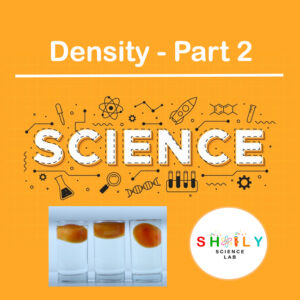Description
Objective
-
Have you ever colored a picture with marker and noticed that two touching colors begin to bleed together? In class, do you typically sit evenly spaced or all scrunched together? Although one of these refers to chemical properties and the latter social interaction, both are examples or diffusion.
Diffusion is the mixing of substances due to the movement of their particles. This can occur with all sorts of matter, but is most commonly observed in liquids and gases. Typically, diffusion refers to the movement of molecules from high concentrations to lower concentrations. The rate of this movement depends on the energy of the molecules. Think of how delicious smells from your kitchen take longer to get into your bedroom than to your living room which is located right beside the kitchen. That is because the molecules from the food odor haven’t diffused into that space yet. In this experiment, you will experience how temperature affects the mixing of food coloring drops with water.
Materials
- An adult helper
- Two clear glasses
- Water
- Food coloring
Procedures.
-
- Make a prediction. What might be different about the way the food coloring moves through the cold water and the hot water?
- At the exact same time, add 2-3 drops off food coloring into each glass. Do not mix or stir.
- Watch what happens to the food coloring. Does it move differently in the hot water than the cold water?
What’s Going On?
Disclaimer and Safety Precautions
Warning is hereby given that not all Project Ideas are appropriate for all individuals or in all circumstances. Implementation of any Science Project Idea should be undertaken only in appropriate settings and with appropriate parental or other supervision. Reading and following the safety precautions of all materials used in a project is the sole responsibility of each individual. For further information, consult your state’s handbook of Science Safety.
Safety
- Put on protective eyewear. Conduct the experiment on the plastic tray and in a well-ventilated area.
- Keep a bowl of water nearby during the experiment.
- Keep flammable materials and hair away from flame.
- Avoid looking directly at burning magnesium to prevent eye discomfort.
- Do not attempt to extinguish the solid fuel and magnesium — let them burn down completely. Do not touch the stove after the experiment — wait until it cools down.
- Do not allow chemicals to come into contact with the eyes or mouth.
- Keep young children, animals and those not wearing eye protection away from the experimental area.
- Store this experimental set out of reach of children under 12 years of age.
- Clean all equipment after use.
- Make sure that all containers are fully closed and properly stored after use.
- Ensure that all empty containers are disposed of properly.
- Do not use any equipment which has not been supplied with the set or recommended in the instructions for use.
- Do not replace foodstuffs in original container. Dispose of immediately.
- In case of eye contact: Wash out eye with plenty of water, holding eye open if necessary. Seek immediate medical advice.
- If swallowed: Wash out mouth with water, drink some fresh water. Do not induce vomiting. Seek immediate medical advice.
- In case of inhalation: Remove person to fresh air.
- In case of skin contact and burns: Wash affected area with plenty of water for at least 10 minutes.
- In case of doubt, seek medical advice without delay. Take the chemical and its container with you.
- In case of injury always seek medical advice.
- The incorrect use of chemicals can cause injury and damage to health. Only carry out those experiments which are listed in the instructions.
- This experimental set is for use only by children over 12 years.
- Because children’s abilities vary so much, even within age groups, supervising adults should exercise discretion as to which experiments are suitable and safe for them. The instructions should enable supervisors to assess any experiment to establish its suitability for a particular child.
- The supervising adult should discuss the warnings and safety information with the child or children before commencing the experiments. Particular attention should be paid to the safe handling of acids, alkalis and flammable liquids.
- The area surrounding the experiment should be kept clear of any obstructions and away from the storage of food. It should be well lit and ventilated and close to a water supply. A solid table with a heat resistant top should be provided
- Substances in non-reclosable packaging should be used up (completely) during the course of one experiment, i.e. after opening the package.
Disposal
Dispose of the reagents and solid waste together with household garbage.











Reviews
There are no reviews yet.